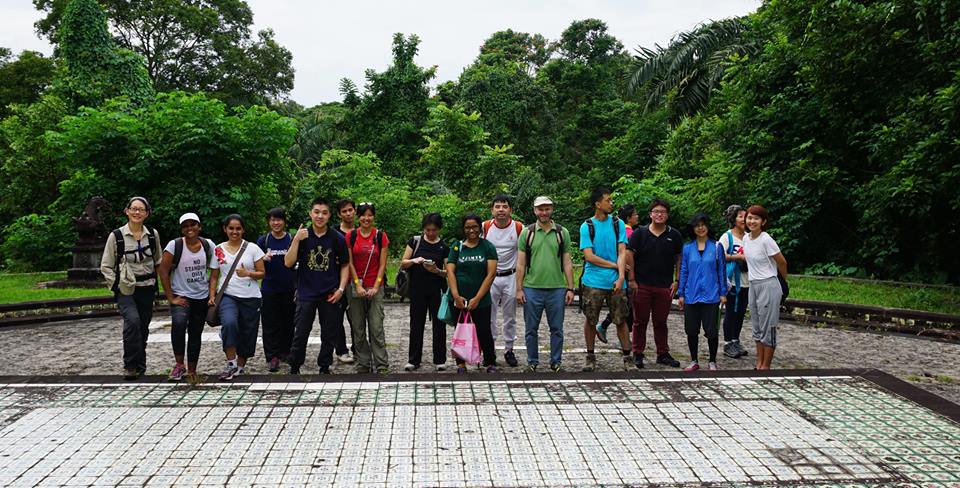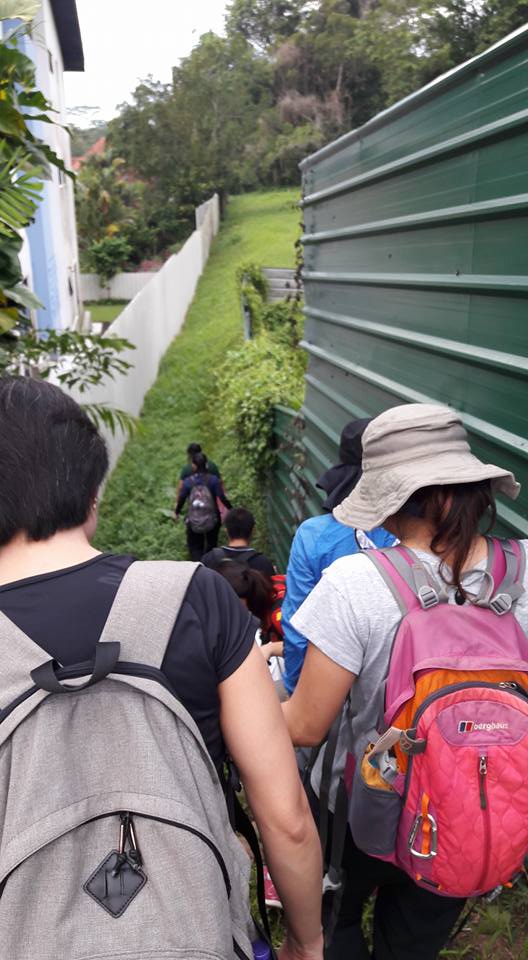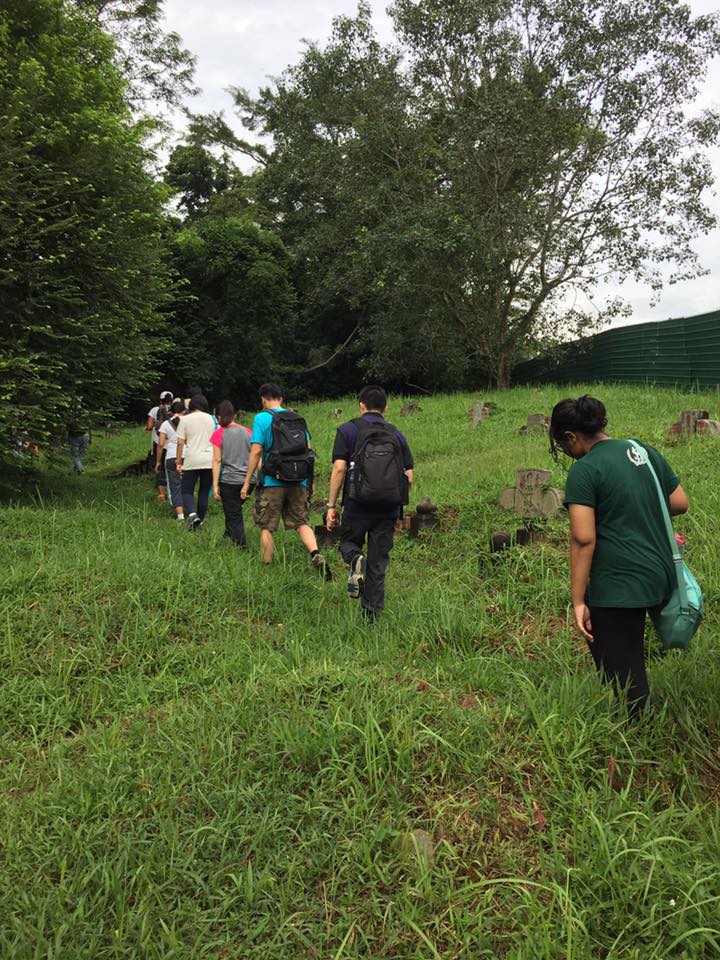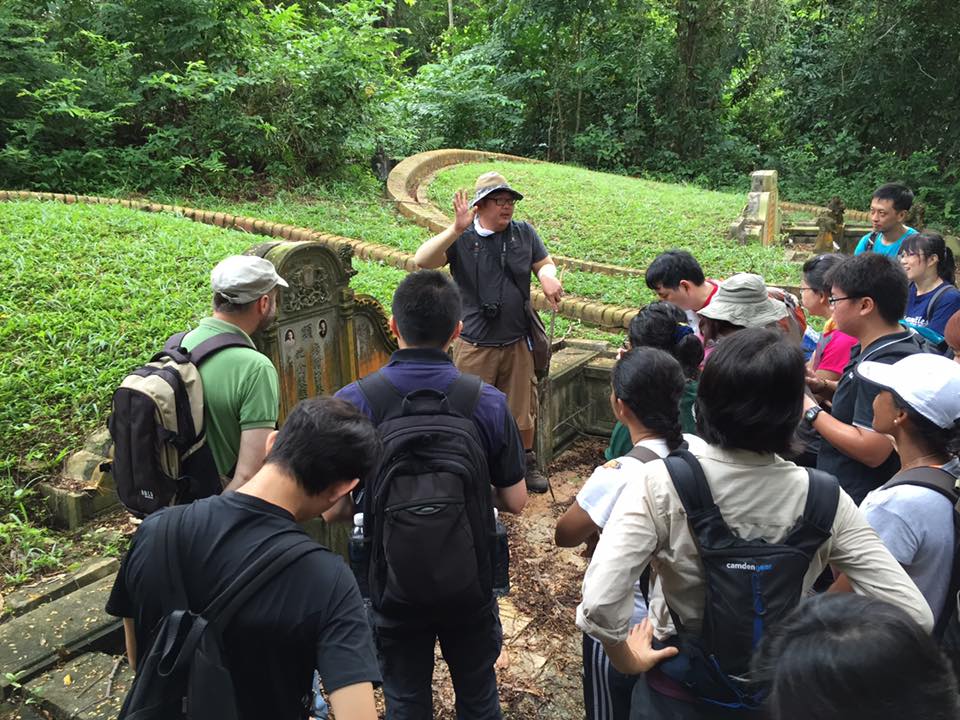Reflections on a Ramble
0On 14 August, Samira Hassan joined Brownie Peter Pak for a Ramble thru’ Bukit Brown to Kopi Sua Cemetery .
It was Samira’s first visit and she penned these reflections to share.
“I doubt there are textbooks or academic sources that would be able to do justice to the arcane yet insightful details the places in Bukit Brown had revealed about our past – and these pieces of our tangible history are truly irreplaceable.”
by Samira Hassan
Dateline: Bukit Brown (14th August 2016)
We started the trail off the sidewalk on Lornie Road near a clearing just pass the turn in to Caldecott Hill. It would have been all too easy to miss it whilst walking – overgrown creepers had landscaped the steep steps that led us down the path to the trail. The steps themselves were uneven and rickety, an omnipresent feature in Bukit Brown’s landscape.
The cemetery is sprawled over 5 hills (blocks) as high ground was thought to represent the back of a dragon, an auspicious symbol in Chinese culture.
We first made our way to the tomb of Lim Kee Tong and his wife.

Grave of Mr and Mrs Lim Kee Tong, note the grape vines on the border to the tombstone (photo Catherine Lim)
Their tombstone was largely inspired by post-modernist designs of colonial times with Chinese lions. A mound behind the tombstone is where they are buried, enclosed in a horseshoe shape defined by a brick border. Each feature on the tombstone it seems had its own specific meaning; for example, the vines of grapes at the border of the headstones, because of its seeds, signified the wish for many more generations to follow.
The horseshoe shape is also reminiscent of a womb, alluding to the circle of life. The design of the grave incorporates a drainage system which would direct rain water to flow to the bottom, an important component in fengshui. Water is “chi” or energy and also represents wealth. Diverting water away from the mound helps to stay the course of decomposition, although it is inevitable.
Inscriptions on the tombstones included names of the deceased, dates of death and place of origin. It was explained that sometimes posthumous auspicious names were given as mark of respect by the children. Names of children are also included in the inscriptions so it seems like each grave is family monument in itself. Features and inscriptions on each grave can reveal some aspect about the person’s life and hopes for the family.
And in Bukit Brown, every grave has a story to tell – even the grave of paupers. Moving into the pauper area of Bukit Brown, we learned of the rickshaw puller Low Nong Nong who died in clashes with police when rickshaw pullers went on strike and demonstrated against the increment of rickshaw rentals.
The other rickshaw coolies then pooled together enough money to buy Nong Nong a tombstone and a funeral to acknowledge his sacrifice. In the midst of the other *pauper tombstones where there was barely enough money to erect a simple headstone, Nong Nong’s tombstone was comparable in size to the tombs in the paid plots and also because the mound itself had been cemented over, perhaps because his comrades realised that since he died without kith and kin, there would be no one to help maintain his grave should they themselves pass on or manage to make enough money to return home to China
*Under the colonial administration, free plots in Bukit Brown were set aside for those who died destitute
The fact that even paupers like this rickshaw puller had a story, had a voice, was something that I really appreciated in Bukit Brown: there was no particular class, or group of people, that were entitled to the plot of land, that all of these seemingly disparate narratives had managed to tell a bigger story of Singapore’s history. Such heterogeneity transcended into Ong Sam Leong’s tomb as well, the biggest one in Bukit Brown.

Group photo of ramblers at Ong Sam Leong’s grave, Samira is in the middle in green tshirt, carrying blue and pink tote bags (photo Peter Pak)
The most fascinating thing about his grave were the statues of the Punjabi guards stationed at each side. Around Malaya at that point in time, the British had recruited Punjabi soldiers and policemen from India. Given their positions of authority, they were almost seen as the “guardians of the state” They became also personal body guards of rich towkays such as Ong Sam Leong at a time where lawlessness was more prevalent. For me it demonstrated a deep level of trust between diverse communities and reflected a nascent multicultural society Singapore in the 1900s.

Sikh guards protecting a Chinese reformist fugitive from the Qing Dynasty, Kang You Wei when he sought refuge in Singapore. (Photo from Lai Chee Kien)
Bukit Brown has grown to be more than a resting place for the deceased – it has become a physical emblem of a society that was present in early 20th-century Singapore. From the most minute details in the tombs to the way the entire cemetery is organized – all of these provide important snippets to what civil society used to be like back then, I think this really goes to show that there is sometimes no alternative for trails and fieldwork such as this one.
I doubt there are textbooks or academic sources that would be able to do justice to the arcane yet insightful details the places in Bukit Brown had revealed about our past – and these pieces of our tangible history are truly irreplaceable.
=================
Samira is a year 5 student with Raffles Institution, who is currently serving an internship with Singapore Heritage Society to better understand the challenges of conservation and heritage development
Information on public guided walks when and where and how to register can be found by following Bukit Brown Events on Peatix





Comments